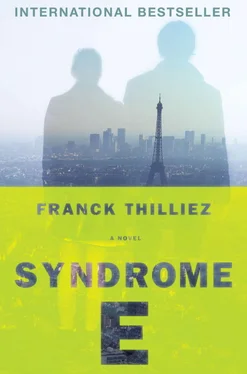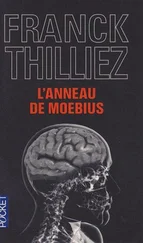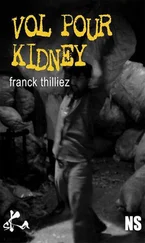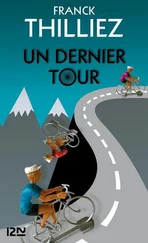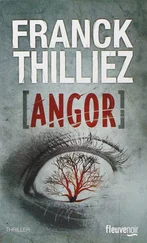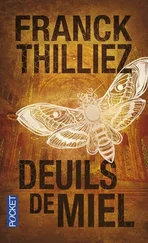“Wait a minute. Just before they shot him, Rotenberg was telling me about mental contamination. With everything that happened afterward, it had slipped my mind. Open the file.”
“A batch of photos, it looks like.”
The slide show began, delivering its pixelated poison. They saw the pictures of the German soldier aiming at the Jewish women, which the police had already seen at the meeting in Nanterre. The eyes of the soldier in the foreground had been circled in marker.
“His eyes… That’s what Szpilman wanted to call attention to.”
The following series of photos: mass graves.
The bodies of Africans in heaps, tangled together, gathered up by the army. The inhuman expression of a vile massacre.
“Rwanda,” the inspector murmured with difficulty. “Nineteen ninety-four. The genocide.”
A particularly horrible image showed the Hutus in action, armed with their machetes. The faces of the aggressors were contorted in hatred, their lips frothing with saliva, the veins on their necks and arms bulging beneath the skin.
Once again, the killers’ eyes were circled. Lucie moved her face closer to the screen.
“Always the same look in the eye, always… The German, the Hutu, the little girl with the rabbits. It’s like… a common feature of madness, transcending cultures and time periods.”
“Different forms of mass hysteria. We’re in the thick of it.”
The war correspondent had then ventured among the bodies, lingering over the corpses, not shying away from the most horrific close-ups.
The following image froze Lucie and Sharko in complete stupor.
It showed a Tutsi, his eyes missing, his skull cut in half.
The photo bore the caption BEYOND MASSACRE: AN EXPRESSION OF HUTU MADNESS.
Lucie burrowed into her seat, a hand on her forehead. The photographer had thought this was a barbaric act by the Hutus themselves, but the truth lay elsewhere.
“I can’t believe it…”
Sharko pulled on the flesh of his cheeks until his eyes slanted.
“He was there too. The sicko who steals the brains. Egypt, Rwanda, Gravenchon—and how many other places besides?”
Other documents followed: archival photos, scans of articles, or pages from history books.
Each concerned a genocide or a massacre. Burma, 1988. Sudan, 1989. Bosnia-Herzegovina, 1992. Horrible photos, taken in the frenzy of the moment. The very worst that history had to offer was on display before them. And always, eyes circled. Sharko looked for sliced skulls among the mountains of corpses, without finding any more. But they were surely there, somewhere among the dead. They simply hadn’t been photographed.
The cop firmly hit PAUSE.
“Enough!”
He stood up, put his hands to his head, and paced the room. Lucie still couldn’t get over it.
“Mental contamination,” she kept repeating mechanically.
She filed through the last images; then the slide show ended.
Quiet in the room. Discreet rumble of the air conditioner. Lucie rushed to the window and threw it open.
Air. She needed some air.
Sharko squeezed his skull between his hands.
“The killer must have been there… present after every massacre, to steal the brains.”
Pale, Lucie had come back to sit on the bed. She stared blankly at the screen.
“Szpilman didn’t care about the political, ethnic, or existential reasons for the genocides. He was tracking something in those massacres, in which perfectly normal fathers and children suddenly went into a killing frenzy. Just before he died, Philip Rotenberg had talked to me about research that led the Belgian to that business of mental contamination. He’d said there might exist a phenomenon so violent that it could modify the structure of the brain.”
“Like a virus, you mean?”
“Yes, except that there isn’t anything really physical or organic. Just… something that passes through the eye and directly modifies human behavior, that liberates the impulse toward violence.”
“A kind of criminal mass hysteria.”
“In a way. Ever since I saw the film with the girls in the white room, I’ve had an image in mind: they’re like a squadron of warplanes. The lead plane, the one that guides the rest, veers downward, and the other planes follow in formation, one by one, as if they were held together by an invisible thread. What if that’s what this Syndrome E is all about? One highly violent individual sets things off, acts as a catalyst; then the mental contamination of violence spreads almost immediately from person to person? What if that was the goal of the experiments hidden in Lacombe’s film? Trying to re-create the phenomenon for the camera? Establish concrete proof of its existence?”
Sharko walked almost mechanically around the room. Nothing existed around him. The case had absorbed him, and what Henebelle was saying struck him as at once far-fetched and frighteningly on target. Szpilman, through his own research and persistence, had stumbled onto the truth. He had spent years rummaging through books, contacting war zone photographers, collecting images, tracking down a horrifying discovery. Ultimately, the film that had no doubt come to him by arranged accident had been the cornerstone of his research, the missing piece that allowed him to grasp the very essence of his quest.
“There are people on this planet,” he said, “who are trying to understand, medically—I would almost say surgically—the workings of this phenomenon, which Jacques Lacombe recorded more than fifty years ago for the purposes of secret experiments. Violent mental contamination starting from a catalyst. That’s what Syndrome E is.”
“Violent mental contamination starting from a catalyst,” Lucie repeated. “A rare, random phenomenon that can strike anywhere, at any time. You can’t study it in a laboratory, so you go looking out in the field. At the site of massacres, the places where outbreaks of mass hysteria occur. You look in the heads of corpses for a trace, a clue.”
Sharko pursued her line of thinking, his hand on his chin.
“Chastel knew of the existence of Syndrome E, and that means two things. First, that the file, which in the fifties was in the hands of the CIA, has now been acquired by the French secret service. And second, that it’s… intrinsic to the Legion itself. It’s about a place where men, especially during the selection phase, are pushed to their physical and psychological limits. Where the slightest detail could suddenly set one of them off.”
“The Legion is the perfect breeding ground for mental contamination. Is that what you’re saying?”
“Exactly. Think of the photo of those soldiers facing the Jewish mothers, or the Hutus brandishing their machetes, the inherent violence of those scenes, their context. No doubt there are triggers that help bring about the syndrome, like stress, fear, external conditioning…”
“War, confinement… anything that involves some form of authority. Sister Marie talked about the anxiety the little girls exhibited after they’d been locked in those rooms and shouted at.”
Sharko nodded emphatically.
“Absolutely. Before taking over as top commander, Chastel led the survival training in Guiana, a hellhole that could drive even legionnaires insane. There might have been an outbreak of the syndrome there. From that, Chastel might have caught the eye of our brain thief. He then did a stint with the secret service before ending up in Aubagne. I believe he was appointed top commander specifically to try to trigger Syndrome E among his own men, so that they could study the phenomenon on living beings.”
“A kind of incubator. The equivalent of the 1955 experiments, but outdoors.”
Читать дальше
